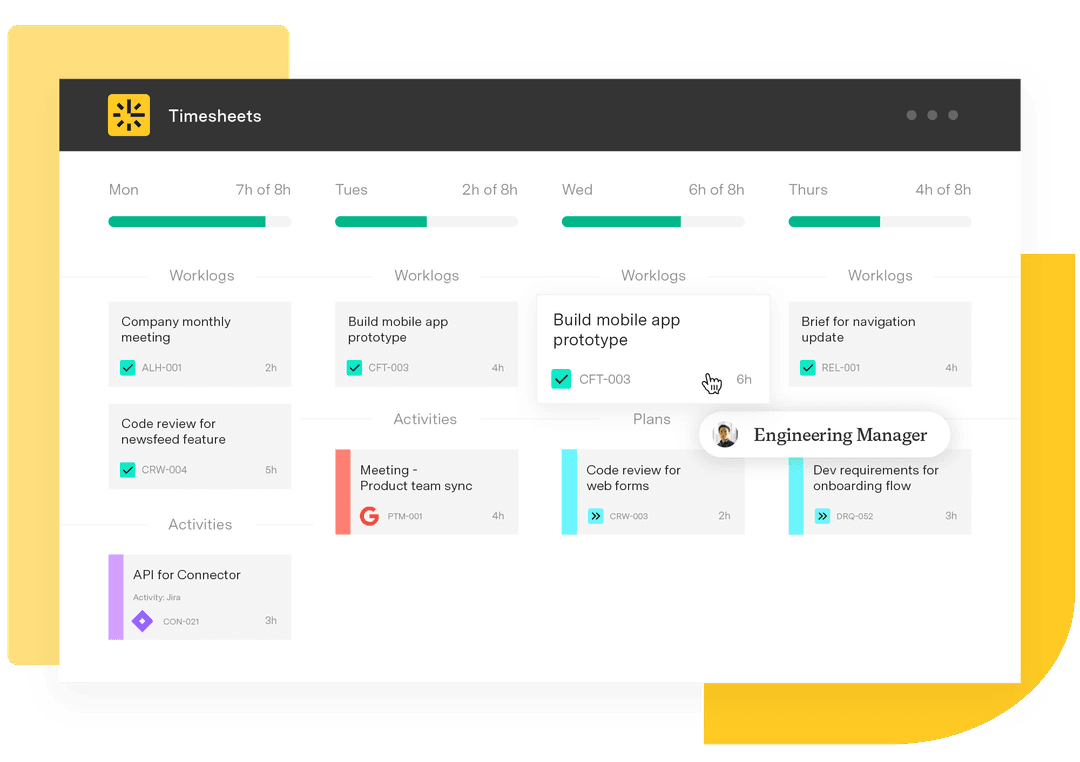Executive summary example for clear business reports
Tempo Team
Every business report has a purpose, but not every reader has time to digest multiple pages of information. That’s where an executive summary comes in. When done well, it provides a fast, accurate overview of the details that matter most, helping high-level stakeholders quickly understand the key points, decisions, and outcomes.
In this guide, we’ll define an executive summary, explore its benefits, walk through how to write one effectively, and provide executive summary examples tailored to common business scenarios. We'll also explain how Tempo tools help teams access the structured data they need to create clear and actionable summaries.
What’s an executive summary?
An executive summary is a short, structured synopsis of a longer document. It typically appears at the beginning of project proposals, research reports, or financial reviews. Its role is to give busy decision-makers a clear view of the document’s purpose and recommendations without requiring them to read the entire report.
Think of an executive summary as a guidepost. It orients the reader by distilling the most pertinent information into an easily readable format. A good executive summary is concise, objective, and written with its audience in mind.
Benefits of an executive summary
An executive summary isn’t just a formality – it plays a valuable role in improving communication and decision-making. Here are a few key advantages:
Saves time for stakeholders by distilling the full report into a quick, digestible overview. Executives and other decision-makers can grasp the core purpose and conclusions without reading every detail.
Clarifies goals and recommendations so leadership can take informed action. By summarizing key findings, it eliminates ambiguity and provides guidance on the next steps.
Improves accessibility for diverse audiences by translating technical or operational details into straightforward language. High accessibility ensures that team members, clients, or external partners can follow the narrative even if they’re not experts in the subject matter.
Enhances alignment across teams and departments by creating a shared understanding of the report’s objectives and outcomes. A concise summary reduces miscommunication and keeps everyone focused on common priorities.
Encourages best practices by prompting teams to focus on relevance and conciseness. Writing a summary pushes report authors to identify what matters most and communicate it effectively.
How do you write an executive summary? 5 tips
Here are five tips on writing executive summaries that effectively describe a document’s overall contents.
1. Start with a purpose
Begin by explaining why the full report exists. Ask yourself: What’s the main goal or problem being addressed? Who’s the intended audience? If you’re writing for leadership, emphasize strategic outcomes. If you’re writing for clients or partners, explain how your work aligns with their interests or solves a specific challenge.
2. Summarize key findings
After establishing the purpose, outline the most important points, which could include major discoveries, proposed solutions, or high-level strategies. Avoid deep technical details, but be specific enough to show the reader that you’ve done the work and drawn actionable conclusions.
3. Highlight outcomes, metrics, or decisions
Include measurable results, financial implications, or critical decisions that resulted from the report. These elements add credibility and help stakeholders quickly assess impact. When possible, use concrete data, such as cost savings, timeline improvements, or performance benchmarks.
4. Write the summary last
Even though the executive summary appears first, it's best to write it after everything else. Writing it with all the available data in mind allows you to practice good project documentation practices by avoiding inconsistencies in your reporting. Once the document is finalized, distill the major themes and insights into a concise summary that reflects the full scope of the work.
5. Keep it brief
Aim for one or two paragraphs, or one page at most: Every sentence should serve a purpose. The goal is to give readers enough information to understand the value of the report without overwhelming or confusing them, so avoid jargon, repetition, and filler language. A well-written executive report stands on its own while encouraging the reader to explore the full document if they desire.
Executive summary examples
Executive summaries are useful in many business environments, but their purpose is always the same: They provide a concise overview highlighting key insights, decisions, or recommendations for a given audience.
Below are a few executive summary template examples that show how they can be adapted to fit different contexts.
Project summary
This summary should align with your project roadmap and condense the key components of your proposal, including goals, timelines, methodology, and budget. It allows stakeholders to understand the proposed work without reading the entire document and supports informed decision-making.
Project executive summary example:
This project proposal outlines a six-month rollout of a centralized customer support platform. The initiative seeks to improve ticket resolution time, reduce support costs, and increase customer satisfaction. Key phases include selecting a software vendor and migrating legacy systems. The project is scheduled to begin in Q3 and targets a 20% efficiency improvement by the end of Q4.
Business plan summary
An executive summary for a business plan distills the core concepts behind a company's monetization strategy. After completing the full plan, summarize the most important sections, such as growth targets, funding needs, and financial projections. This helps potential investors or stakeholders quickly assess the plan's value.
Business plan executive summary example:
This business plan presents a three-year strategy for a sustainable packaging startup. The company plans to expand into two regional markets, launch a direct-to-consumer sales channel, and raise Series A funding. The financial forecast anticipates two million in revenue by year three, with a focus on profitability and a strong operations strategy to support scaling.
Research report summary
Executive summaries for research documents summarize the findings, methodology, and recommendations of a study. They’re helpful for readers lacking technical expertise who need a snapshot of the research outcomes.
Research report executive summary example:
This report analyzes employee productivity trends across five departments over the last fiscal year. Using a mixed-methods approach, the study found that flexible work policies were associated with a 12% increase in task completion rates. The report recommends expanding hybrid work options and revising performance criteria.
Product launch summary
An executive summary for a product launch outlines the strategy, goals, and key performance indicators associated with bringing a new product to market. It gives stakeholders a high-level view of launch plans, helping with team alignment and resource allocation.
Product launch executive summary example:
This summary highlights the launch strategy for a new AI-powered budgeting tool. The campaign includes phased release dates, an onboarding webinar series, and outreach to existing customers. Initial targets focus on maintaining user retention, lowering support ticket volume, and increasing conversion rates from free trials to paid accounts. The launch is scheduled for September, with monthly reviews to assess traction.
An executive summary can also accompany a business requirements document for a more detailed plan, clarifying scope and technical needs at a glance.
Strengthen reporting clarity and alignment with Tempo
Executive summaries are only as informative as the data that supports them. That's why it's essential to track time, cost, and resource metrics effectively.
Tempo tools like Timesheets and Financial Manager help teams surface data faster, reducing manual effort and improving visibility. With Timesheets, teams can track time spent on specific projects, identify bottlenecks, and ensure resource alignment. Financial Manager complements this by consolidating cost data, giving leaders a clearer picture of project budgets and financial impact.
Whether you're writing an executive summary for a client, communicating project updates across teams, or surfacing CEO-level insights, Tempo gives you the visibility you need to guide strategic decisions.













































